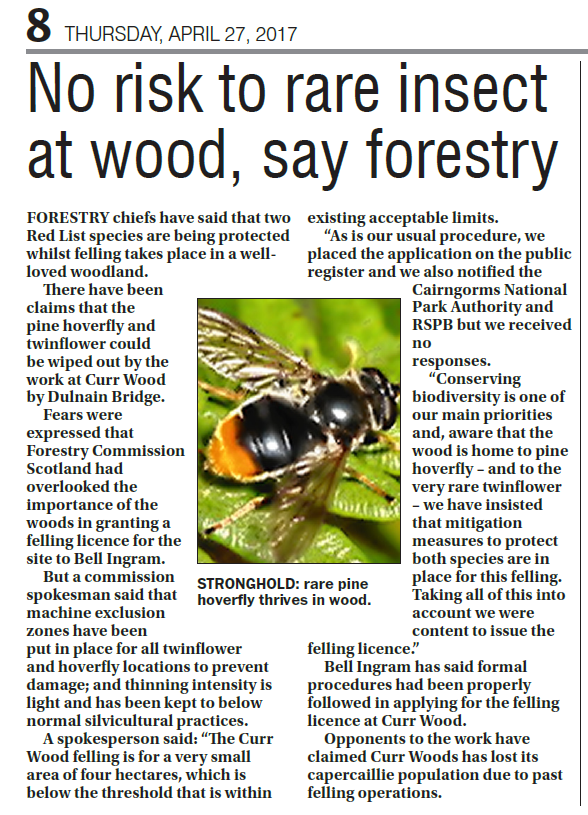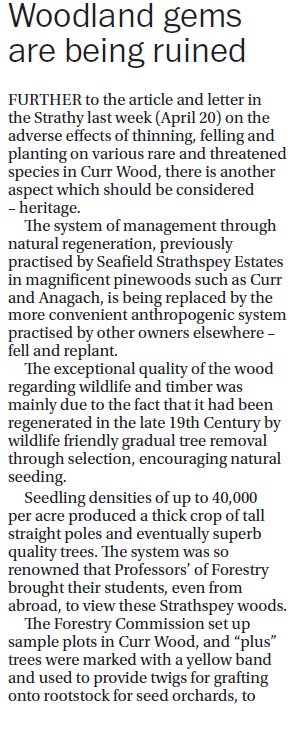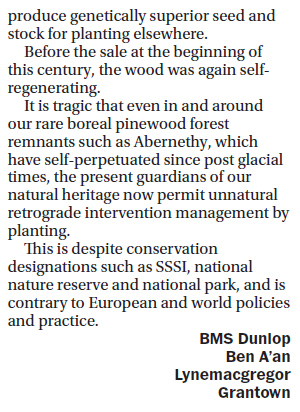 On 27th April, the same day the above article appeared in the Strathie about felling at Curr Wood, on Speyside, SNH’s latest post on Scotland’s Nature popped into my inbox https://scotlandsnature.wordpress.com/2017/04/27/time-to-celebrate-bugs-in-the-cairngorms-national-park/. And guess what bug featured? One so rare that …………….it only occurs at a single location in the National Park, Curr Wood………….shome mistake surely!
On 27th April, the same day the above article appeared in the Strathie about felling at Curr Wood, on Speyside, SNH’s latest post on Scotland’s Nature popped into my inbox https://scotlandsnature.wordpress.com/2017/04/27/time-to-celebrate-bugs-in-the-cairngorms-national-park/. And guess what bug featured? One so rare that …………….it only occurs at a single location in the National Park, Curr Wood………….shome mistake surely!
Cairngorms Nature
One example is the pine hoverfly. Due to intensification of forest management over the decades this is now an endangered species, so rare in fact that it is restricted to a single location in the Cairngorms National Park. It depends on the deadwood cycle – the process of trees (in this case big old granny pines) falling over or succumbing to fungal disease and decaying. The pine hoverfly’s larvae live in wet role holes created by this process – a very specific niche. Natural occurrences of these “rot holes” are nowadays few and far between because most pines in forestry are felled before they get to be old, knarled granny pines. To help save the pine hoverfly from extinction, a range of organisations in the park have been making artificial holes in tree stumps to give the pine hoverfly a home. It is hoped that in the future numbers of the hoverfly will increase to levels that allow it can survive on its own, and with more pine forest in the park being managed less intensively, natural rot holes should become common again.
Thank goodness our public authorities don’t always co-ordinate what they put out to the media. The cracks between them are most revealing. And for a broader view of what is going wrong with the approach to tree “management” in the National Park, the same issue of the Strathie contained this very interesting letter from Basil Dunlop which appears to re-inforces previous points made on parkswatch about Loch an Eileen (see here).


Cairngorms Nature Big Weekend 12th – 14th May
The place of nature in the Cairngorms National Park is highly contested and full of contradictions and this is evident in the events being organised for the Big Nature Weekend (see here). There are some great events on and, due to the current attempts to criminalise people who enjoy the countryside in the Loch Lomond and Trossachs National Park, I particularly liked this one at Invercauld:
Description
Collecting wood for lighting fires is now of course a criminal offence in the LLNPA camping management zones, incurring a fine of £500 and a criminal record. So what’s being promoted in the Cairngorms National Park Authority is a criminal offence in the LLTNPA! This just shows how completely out of touch the LLTNPA are.
On May 1st though the CNPA put out a Cairngorms Nature email which highlighted events that were taking place on five estates under the heading “Behind the Scenes” which just so happens to be the same heading used Natural Retreats on their blog to explain what they are doing at Cairngorm!
Behind the Scenes
Part of the Cairngorms Nature Big Weekend is about offering opportunities that are not normally available to the public.
Landscape management is vital to the long term future of the Cairngorms National Park, it is a challenging task which is all about balance. The weekend will offer a number of opportunities to join the people who look after our landscapes on a day to day basis and get an exclusive ‘behind the scenes’ tour of a working estate.
There are events happening in Strathspey, Phoines Estate, Corgarff, Glenmuick and Balmoral. Please click on the relevant area above to find out more and book a place.
The claim that landscape management is vital to the long term future of the Cairngorms National Park is highly ideological. What about the wild land/rewilding view? This explains that the reason why so much of the National Park is degraded in conservation terms is precisely because there is too much management: muirburn, proliferation of bulldozed tracks. Indeed one could cite the felling and replanting at Curr Wood.
The CNPA would, I guess, respond by saying “its all about balance” – to which the question needs to be asked, balance between what? Unfortunately while promoting these events at the Big Nature Weekend there appear to be no events being promoted by RSPB, SNH or NTS which might demonstrate some alternative ways of managing the land.
Click on Corgarff and you will find the event is on the Allargue Estate, which is described as conservation-minded – this is the estate where all the vehicles were parked that took place in aninfamous mountain hare massacre featured on Raptor Persecution Scotland (see here). The event is called “A Question of Balance – Wildlife and Land Management”. It makes you want to cry.
What needs to happen
The CNPA needs to stop promoting estates which do not adhere to the standards for conservation we should expect in National Parks. Now maybe the Allargue Estate has made a commitment to stop culling mountain hares. If so, I would applaud that but if not, the CNPA should not be promoting it.
The new Cairngorms Partnership Plan provides an opportunity for the CNPA to ask all estates within the CNPA that have not already done so to submit an estate management plan and for those who have them, to revise their current plans. Such plans should contain transparent statements on what wildlife is killed by estates, either for “sport” or “protection of wildlife”, on practices such as muirburn and how the estate is going to play its part in meeting the conservation objectives set out in the Partnership Plan.
